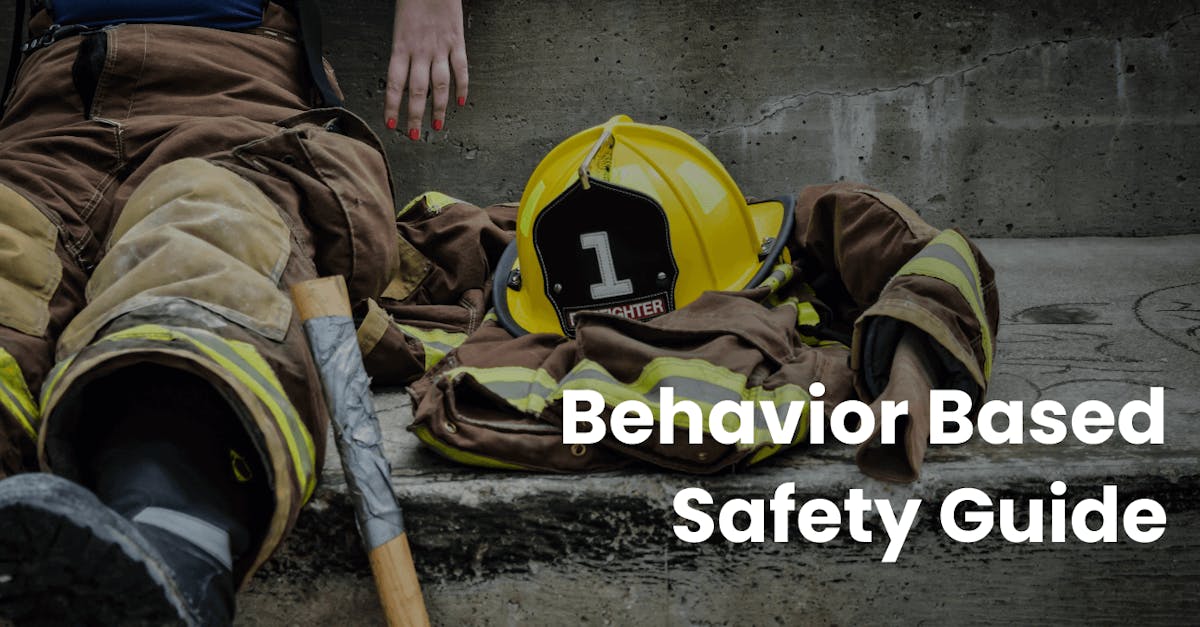Behavior Based Safety Guide

Behavior based safety applies behavioral analysis principles and methods to industrial safety. These principles are based on more than four decades of rigorous scientific research, which include positive reinforcement and corrective feedback. The goals of these approaches were to increase appropriate behaviors and decrease improper behaviors.

These days, the consensus remains that behavior based safety training is an important investment for any organization that values the health, safety, and well-being of its employees. Research has also proven that behavior-based safety can reduce workplace injuries.
In this article, we’ve written a comprehensive behavior based safety guide to help you understand everything there is to know about behavior based safety. We will also walk you through steps and strategies for implementing this type of safety training in your organization.
What is Behavior Based Safety?
Behavior based safety is an approach to managing safety in the workplace. It focuses on the behavior of employees and how it can be modified to reduce workplace accidents and injuries. The idea behind it goes like this: if many accidents are caused by unsafe behavior, then accidents can be prevented by changing that behavior.

This safety management approach is commonly used in high-risk industries such as construction, manufacturing, healthcare, and transportation. It involves identifying unsafe behaviors and coaching employees to help them develop safer habits. This is done through a combination of training, reinforcement, and feedback, to create a culture of safety within the organization.
History of Behavior Based Safety
The history of behavior based safety dates back to the 1930s when psychologist B.F. Skinner introduced the concept of operant conditioning. This concept suggests that behavior can be influenced by its consequences.

Some companies began to use techniques that modify behavior to improve workplace safety in the 1960s. But, it wasn't until the 1980s that behavior based safety programs officially took off.
Since the establishment of the Occupational Safety and Health Administration (OSHA) in 1971, safety professionals have devised diverse safety programs and techniques to decrease the occurrence of workplace fatalities and injuries.
In 1992, the National Safety Council published a book called Accident Prevention Manual for Business and Industry: Administration and Programs. This manual first introduced the concept of behavior based safety in the workplace. Since then, many organizations have started adopting behavior based safety programs.
However, the effectiveness of behavior based safety has been a subject of debate. This is because the approach focuses on changing employees' behavior rather than just improving the physical environment or implementing new rules and regulations.
Proponents argue that behavior based safety programs can lead to significant improvements in workplace safety. Critics say that it often leads to blaming workers rather than addressing systemic issues that contribute to accidents.
Benefits of Behavior Based Safety
Despite these debates, however, behavior based safety remains a popular approach to improving workplace safety in organizations worldwide. After all, behavior based safety programs have proven benefits that lead to improved safety cultures within organizations.
Instills a sense of shared responsibility

For one, safety programs help to instill a sense of shared responsibility for safety. This is because employees are encouraged to take responsibility not only for their safety but also for the safety of their colleagues.
Reduces workplace accidents and injuries

By identifying and addressing unsafe behaviors, these programs also help to reduce workplace accidents and injuries. In turn, this will also improve productivity and reduce costs associated with accidents and workers' compensation claims.
Encourages employees to engage in the safety process
These programs also help to engage employees in the safety process by giving them a voice in addressing safety issues. Ultimately, this leads to increased job satisfaction and morale, as well as a sense of ownership and pride in their work.

Behavior based safety programs also involve regular communication and feedback between employees and supervisors. This means that just like any other feedback-drive program, these safety programs are set to improve teamwork within the organization.
Helps organizations meet regulatory requirements

Finally, these programs help organizations meet regulatory requirements for workplace safety by demonstrating a commitment to safety and implementing effective safety programs. This is exactly why this behavior based safety guide is here to help your organization meet these requirements.
Key Principles of Behavior Based Safety

As a proactive approach to improving workplace safety, behavior based safety has the following key principles:
- Positive Reinforcement: This principle forms the basis of behavior based safety. Positive reinforcement means rewarding employees for safe behavior, rather than punishing them for unsafe behavior. Rewards can take many forms, such as recognition, bonuses, or time off.
- Observation and Feedback: Observing employees helps to identify behaviors that could potentially lead to accidents or injuries. If necessary, constructive feedback is given to suggest ways on improving their behavior.
- Employee Involvement: Employees need to be involved in the process of identifying and addressing safety issues, which they experience firsthand in the workplace. They should be encouraged to report unsafe behavior or conditions and to suggest ways to improve safety.
- Continuous Improvement: Behavior based safety is an ongoing process. Thus, the safety program must be constantly monitored and evaluated, so that changes can be made when needed.
- Leadership Commitment: Behavior based safety programs require leadership commitment. Senior management must be committed to the safety program, and actively participate in its implementation and evaluation.
Importance of Behavior Based Safety Training
The importance of behavior based safety training lies in its ability to give employees the knowledge and skills they need to promote a positive safety culture.

Behavior based safety training helps employees become more aware of the potential risks and hazards in the workplace, as well as the behaviors that can lead to accidents. The training also reduces the number of workplace accidents and injuries by identifying and addressing the root causes of unsafe behavior.
Also, the training enhances safety culture by encouraging employees to take an active role, and by emphasizing the importance of safe behavior. Behavior based safety training also stimulates open communication between employees and management to prevent accidents before they occur.
Lastly, behavior based safety training improves productivity. A safer workplace leads to increased productivity since employees are less likely to be absent due to injury or illness. They are also more focused on their work when they feel safe and secure.
Case Studies of Behavior Based Safety Training Programs
Workplace injuries are harmful to employees, their loved ones, and their employees. U.S. companies spend billions of dollars each year to cover the cost of these injuries. To solve this problem, safety programs have been marketed and implemented in various companies so that workplace hazards are lessened, and accidents are reduced.

Strong scientific research backs up the fact that behavior based safety examples can significantly reduce workplace injuries. In a case study at the NASA Langley Research Center, it was found that their behavior based safety guide directly lowered the number of safety incidents in their facility.
In a three-way comparison of three well-known behavior based safety programs, the conclusion was similar. The implementation of all programs resulted in dramatic reductions in the number of lost time and minor injuries that companies have experienced within the last 30 years. This means that behavior based safety programs directly improve productivity and workplace safety.
Another case study on behavior based safety in construction sites also demonstrated large decreases in unsafe behavior and significant increases in safe behavior. To achieve these results, the study emphasized the importance of goal setting, feedback procedures, and management committed to improving safety behavior and performance.
Examples of Behavior Based Safety Training
Behavior based safety training describes the training required for the implementation of behavior based safety examples. This includes training for observers, trainers, and employees to encourage safe behavior.

Behavior-Based Safety training can take many forms, depending on the needs of the organization and the nature of the workplace. Here are some examples:
- Hazard Identification: This type of training teaches employees how to identify potential hazards in the workplace and report them to management. This can include training on how to conduct safety inspections, recognize warning signs, and report unsafe conditions.
- Behavior Observation: Behavior observation training establishes ways on how to observe and record the behavior of coworkers. This is done to identify unsafe behaviors and give feedback on how to correct them.
- Safety Leadership: Safety leadership training focuses on the skills and knowledge that management needs to effectively lead and promote a positive safety culture This can include training on how to set safety goals, communicate effectively with employees, and offer feedback on performance.
- Personal Protective Equipment (PPE): PPE training orients employees on how to properly use and maintain PPE such as gloves and goggles to protect themselves from workplace hazards. Online courses are also available on using PPE for various industries like manufacturing, dentistry, construction, and more.
- Emergency Response: Emergency response training teaches employees how to safely and effectively respond to emergencies or accidents.
EdApp’s 100% free, editable Course Library can give you access to a wide range of behavior based safety training courses, from hazard identification and emergency response to site safety management training courses.

Various high-risk industries like construction, food, and healthcare, which will benefit the most from behavior based safety training, are all accommodated in these EdApp courses. EdApp also offers useful safety training knowledge in its PPE, first aid, and emergency evacuation training courses.
Behavior Based Safety Training Roles and Responsibilities
The success of behavior based training programs depends on the active involvement of all stakeholders. Each stakeholder has a unique role and responsibility to make sure that safe behaviors are adopted and maintained in the workplace.
Management

First, management sets the tone for safety culture and establishes policies and procedures that support safe behaviors. They also guarantee that resources are available for the successful implementation of safety training programs.
Supervisors

On the other hand, supervisors monitor and reinforce safe behaviors in the workplace. They make sure that employees are trained on safe work practices and that they are following safety protocols. Supervisors also recognize and address unsafe behaviors and give feedback to employees.
Safety Professionals

Safety professionals such as trainers and consultants are responsible for developing, implementing, and managing safety programs. They are the ones who are knowledgeable about behavior based safety guide concepts and strategies. So, they should also have the skills to train employees, analyze data, and identify areas for improvement.
Employees

Last but not least, employees are responsible for their safety and the safety of their colleagues. They must actively join safety training programs and adopt safe behaviors in the workplace. Employees should also report unsafe conditions or behaviors to their supervisors.
Get all of your team members involved in their safety training roles and responsibilities with EdApp, a mobile-first learning platform that’s specially designed for training. With EdApp’s Creator Tool, you can create engaging and interactive modular training programs, which are specifically focused on behavior based safety examples. In these courses, you can demonstrate real-life scenarios to help them understand the importance of their roles and the consequences of not following safety protocols.

If you need extra help with creating these training courses, EdApp’s also got you covered with its Course Creation Services. A team of expert instructional designers will be there to help you create awesome learning content that is sure to make an impact on your team.
Implementation of Behavior Based Safety Training

The implementation of behavior-based safety training is a process that involves several key steps, including:
- Conducting a Needs Assessment: Before implementing training, it's essential to conduct a needs assessment to determine the training needs of the organization. This assessment should identify specific safety issues, employee behavior patterns, and any gaps in current safety training programs.
- Defining Safety Goals: Establish clear safety goals that align with the organization's overall objectives. These goals should be measurable and include specific targets for reducing incidents and promoting safe behaviors.
- Developing a Safety Program: Develop a comprehensive behavior based safety guide that includes training materials, communication plans, and performance metrics. The program should be tailored to the organization's unique needs and designed to engage employees at all levels.
- Training Employees: Conduct training for all employees to help them understand the importance of safe behaviors and the impact of their actions on workplace safety. The training should include practical examples of safe and unsafe behaviors and offer strategies for improving safety performance.
- Monitoring and Evaluating Performance: Monitor and evaluate the program's effectiveness regularly by gathering data on safety performance metrics, such as injury rates, near misses, and safety observations. Use this data to identify areas for improvement and make changes to the program as necessary.
- Offering Ongoing Support: Offer ongoing support to employees by reinforcing safe behaviors through regular communication, coaching, and recognition programs. This support will help to sustain a culture of safety and continuous improvement over time.
- Continuously Improving the Program: Continuously evaluate and improve the program based on feedback from employees and changes in the work environment. This approach will help make sure that the program remains relevant and effective over time. Regular training sessions will make sure that employees are consistently following safety protocols, and that safety programs are adjusted to address new risks and hazards.
Beyond creating customized courses, you can also take advantage of EdApp’s mobile learning features, so that your team can access the training content on their mobile devices. With hybrid learning tools, your team can conveniently complete their training at their own pace, whether they are in the office or on the field.

Also, EdApp offers gamification features such as badges, points, and leaderboards. These tools to improve the learner experience can be used to motivate your team members to complete their training and engage with the learning content.
Join EdApp for free to take advantage of all these LMS features for your company’s behavior based safety training.
Behavior Based Safety Training Resources
Here is a list of useful resources mentioned in this article:
- Book: Accident Prevention Manual for Business and Industry: Administration and Programs by the National Safety Council (14th Edition).
a. You can get a copy of this book from the official e-commerce page of the National Safety Council.
b. You may also get a copy of this book and read its description on Amazon. - Case Studies:
a. The Effectiveness of the Behavior Based Safety Program at Jacobs Sverdrup's NASA Langley Rome Contract (published 2006) by Tony A. Mettert, Old Dominion University
b. A Comparison of Three Well Known Behavior Based Safety Programs: DuPont STOP Program, Safety Performance Solutions, and Behavioral Science Technology (published 2007) by Herbert Byrd, Rochester Institute of Technology
c. Behavior Based Safety on Construction Sites: A Case Study (published 2014) by Rafiq M. Choudhry, King Faisal University - Learning Management System: EdApp
Author
Donna Dane
Donna is an elearning content writer for EdApp, a mobile-based microlearning platform designed for today's digital training needs. When she's not writing web articles, she writes lines of code or songs or anything food-related.
